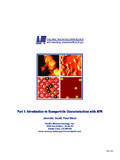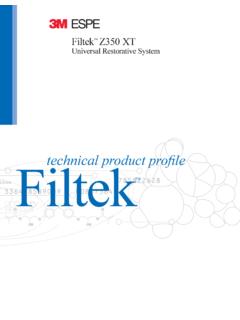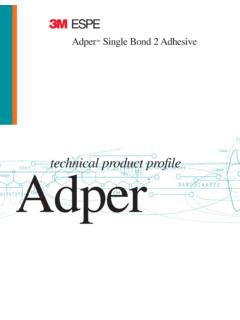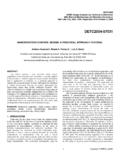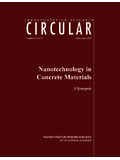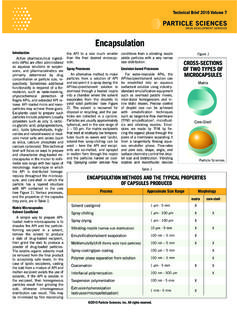Transcription of PLANNING GUIDE FOR PUBLIC ENGAGEMENT AND …
1 PLANNING GUIDE FOR PUBLIC ENGAGEMENT AND OUTREACH IN nanotechnology KEY POINTS FOR CONSIDERATION WHEN PLANNING PUBLIC ENGAGEMENT ACTIVITIES IN nanotechnology ORGANISATION FOR ECONOMIC CO-OPERATION AND DEVELOPMENT The OECD is a unique forum where governments work together to address the economic, social and environmental challenges of globalisation. The OECD is also at the forefront of efforts to understand and to help governments respond to new developments and concerns, such as corporate governance, the information economy and the challenges of an ageing population.
2 The Organisation provides a setting where governments can compare policy experiences, seek answers to common problems, identify good practice and work to co-ordinate domestic and international policies. The OECD member countries are: Australia, Austria, Belgium, Canada, Chile, the Czech Republic, Denmark, Estonia, Finland, France, Germany, Greece, Hungary, Iceland, Ireland, Israel, Italy, Japan, Korea, Luxembourg, Mexico, the Netherlands, New Zealand, Norway, Poland, Portugal, the Slovak Republic, Slovenia, Spain, Sweden, Switzerland, Turkey, the United Kingdom and the United States.
3 The Commission of the European Communities takes part in the work of the OECD. OECD 2012 No reproduction, copy, transmission or translation of this publication may be made without written permission. Applications should be sent to OECD Publishing: PLANNING GUIDE FOR PUBLIC ENGAGEMENT AND OUTREACH IN nanotechnology 3 OECD 2012 FOREWORD The PUBLIC and society at large have become key actors in the development of the field of nanotechnology and this ENGAGEMENT is critical to the acceptance of the technology in marketable products. In recognition of this, strategies for outreach and PUBLIC ENGAGEMENT in nanotechnology have been identified as crucial elements of government policies regarding nanotechnology .
4 The need to clarify how to communicate, with whom and how to engage a wide audience in the debate on nanotechnology , and in the development of policies related to it, has been a major point of discussion amongst policy makers. Conscious of these issues and of the challenges policy makers face in establishing communi-cation strategies, the OECD Working Party on nanotechnology (WPN) in 2007 initiated a project on PUBLIC ENGAGEMENT . In 2009 this lead to the identification of 8 key points designed to assist policy makers in establishing activities for communication and outreach in nanotechnology .
5 These key points for consideration are presented in this PLANNING GUIDE for PUBLIC ENGAGEMENT and Outreach in nanotechnology . The OECD WPN project on PUBLIC Outreach and ENGAGEMENT in nanotechnology was launched in May 2007 through a workshop nanotechnology Outreach Workshop held in Leuven (Belgium) and hosted by the Inter-university MicroElectronics Center (IMEC). From late 2007 until 2008, a survey of national experiences of challenges and practices in nanotechnology -specific PUBLIC ENGAGEMENT , outreach and communication was undertaken using two question-naires.
6 For these surveys, questions were developed to gather information and to establish a common understanding of approaches. In October 2008, a further workshop nanotechnology and PUBLIC ENGAGEMENT was held in Delft, The Netherlands to examine in detail the information gathered through the questionnaires. The Delft workshop launched work on methodologies for good practice in PUBLIC ENGAGEMENT in nanotechnology which could be of use to policy makers. Building on this work, the OECD WPN developed a GUIDE for PLANNING outreach and PUBLIC ENGAGEMENT in nanotechnology .
7 This GUIDE identifies key issues to be considered by policy-makers involved as organisers, commissioners, or funders of PUBLIC ENGAGEMENT activities in nanotechnology . Several WPN member countries including Australia, Ireland, Korea, the Netherlands, and South Africa have made use of the GUIDE since its initial development. Feedback from these countries s the utility of the GUIDE and notes that some aspects of the GUIDE are very useful; however there is room to improve on other aspect. This report presents the PLANNING GUIDE , and details the methodology through which the WPN developed the GUIDE .
8 It details the eight key points for consideration when PLANNING and evaluating PUBLIC ENGAGEMENT activities in nanotechnology . Finally, it provides a critical review of these key points and presents case studies from countries that have been using the GUIDE since 2009 in their communication activities. 4 PLANNING GUIDE FOR PUBLIC ENGAGEMENT AND OUTREACH IN nanotechnology OECD 2012 TABLE OF CONTENTS Introduction .. 5 Approach to developing the GUIDE .. 6 A kick off workshop on nanotechnology Outreach .. 6 A survey of national experiences of challenges and practices.
9 6 A definition and key aspects of PUBLIC ENGAGEMENT : conclusions from the 2008 OECD Delft Workshop on nanotechnology and PUBLIC ENGAGEMENT .. 10 An overview of the PLANNING GUIDE for PUBLIC ENGAGEMENT and outreach in nanotechnology .. 12 Point 1: Identify the context .. 13 Point 2: Be clear about your objective(s) .. 13 Point 3: Identify the participants .. 13 Point 4: Plan the process ..14 Point 5: Select the activity ..14 Point 6: Identify the organisers ..14 Point 7: Know your goals/evaluate and recognise success/engage in follow-up ..14 Point 8: Learn and adapt .. 15 Using the GUIDE , 2009-2010.
10 15 Review of the use of the GUIDE .. 15 Reporting from country case studies ..16 Annex 1: Key points for consideration when PLANNING PUBLIC ENGAGEMENT activities in nanotechnology .. 19 Annex 2: Case studies .. 31 Case study 1: NanoDiscussion-online, a project of the Dutch Nanopodium initiative .. 31 Case study 2: The Critical Thinker Session in South Africa .. 36 Case study 3: Your Science Your Say: nanotechnology , online forum in Ireland .. 39 Case study 4: nanotechnology for Green World in Ilsan/Korea : Nano Korea 2010 Symposium .. 45 Annex 3: Questionnaires to explore national experiences of challenges and practices addressing the topics of nanotechnology -specific PUBLIC ENGAGEMENT .










